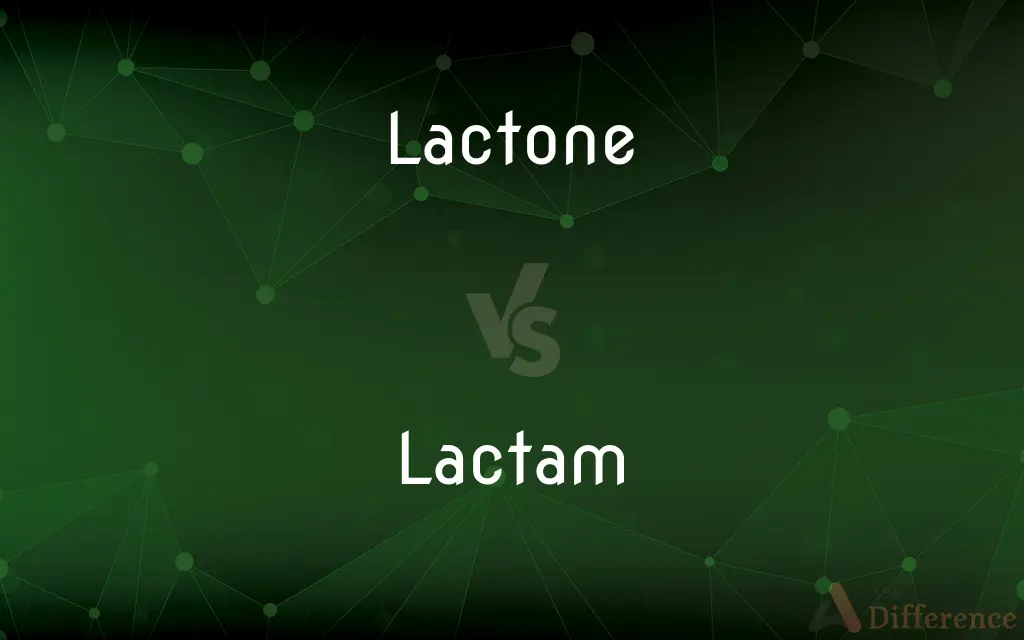Lactone vs. Lactam — What's the Difference?
By Urooj Arif & Maham Liaqat — Updated on April 4, 2024
Lactone is a cyclic ester, while lactam is a cyclic amide.

Difference Between Lactone and Lactam
Table of Contents
ADVERTISEMENT
Key Differences
Lactones are organic compounds characterized by a cyclic structure that includes an ester functional group (a carbon-oxygen double bond connected to an oxygen atom). They are formed by the intramolecular condensation of hydroxy acids, leading to the creation of a ring structure. Lactones are commonly found in various natural substances, such as fruits and flowers, contributing to their flavors and aromas. On the other hand, lactams are cyclic amides, formed through the condensation of amino acids or the cyclization of linear amides. They contain a carbon-nitrogen double bond within their ring structure. Lactams are key components in the structure of many proteins and synthetic polymers, like Nylon, which is a type of synthetic polymer made from lactams.
The synthesis of lactones typically involves the dehydration of hydroxy acids, where water is removed to form the ester linkage within a ring. This process often requires acidic or basic catalysts to proceed. In contrast, lactams are synthesized through methods such as direct cyclization of amino acids or by the ring-closure of linear amides. The synthesis of lactams is crucial in the pharmaceutical industry for the production of various drugs and in the manufacturing of synthetic fibers.
Lactones play significant roles in the flavor and fragrance industries, as their presence in natural products contributes to the sensory qualities of foods and perfumes. They are responsible for the characteristic flavors of some fruits and fermented products. Conversely, lactams have wide applications in the pharmaceutical and materials science fields. They are building blocks for the synthesis of a variety of drugs, including antibiotics and anti-inflammatory medications, and for the production of synthetic fibers and plastics.
Chemically, the reactivity of lactones and lactams differs due to their functional groups. Lactones, being esters, are susceptible to hydrolysis in the presence of water and base, reverting back to their hydroxy acid forms. This reaction is important in both biological systems and industrial processes. Lactams, with their amide bonds, exhibit a degree of stability against hydrolysis, making them useful in applications where resistance to chemical breakdown is needed, such as in long-lasting synthetic materials.
In terms of biological significance, both lactones and lactams are found in and synthesized by living organisms. Lactones often serve as pheromones or signaling molecules in plants and animals. Lactams, due to their structural similarity to peptide bonds found in proteins, are involved in biological processes and can interact with biological systems in unique ways, making them valuable in drug design and biotechnology.
ADVERTISEMENT
Comparison Chart
Definition
A cyclic ester derived from hydroxy acids.
A cyclic amide derived from amino acids or linear amides.
Formation
Intramolecular condensation of hydroxy acids.
Cyclization of amino acids or linear amides.
Key Components
Carbon-oxygen double bond connected to an oxygen atom.
Carbon-nitrogen double bond.
Synthesis
Dehydration of hydroxy acids.
Cyclization of amino acids or direct synthesis.
Applications
Flavor and fragrance industries, natural product chemistry.
Pharmaceutical industry, synthetic polymers and fibers.
Chemical Reactivity
Susceptible to hydrolysis, forming hydroxy acids.
More resistant to hydrolysis than lactones.
Compare with Definitions
Lactone
Derived from the intramolecular condensation of hydroxy acids.
The formation of lactone is essential in the fragrance of peaches.
Lactam
A cyclic amide formed from amino acids.
β-Lactam antibiotics are crucial in fighting bacterial infections.
Lactone
An organic compound forming a cyclic ester.
γ-Butyrolactone is a lactone used in various chemical syntheses.
Lactam
Exhibits stability against chemical breakdown.
Lactams' resistance to hydrolysis makes them suitable for durable materials.
Lactone
Used in the flavor and fragrance industries.
Many perfumes contain lactones for their sweet and fruity aromas.
Lactam
Key component in synthetic polymers like Nylon.
The production of Nylon-6 involves the polymerization of a lactam.
Lactone
Susceptible to hydrolysis, reverting to hydroxy acids.
Lactones can hydrolyze in aqueous solutions, affecting their stability.
Lactam
A cyclic amide, or any compound containing it, formed by the intramolecular condensation of an amino carboxylic acid.
Lactone
Commonly found in natural substances, contributing to flavors.
Lactones give coconuts their distinctive smell.
Lactam
A lactam is a cyclic amide, formally derived from an amino alkanoic acid. The term is a portmanteau of the words lactone + amide.
Lactone
Lactones are cyclic carboxylic esters, containing a 1-oxacycloalkan-2-one structure (−C(=O)−O−), or analogues having unsaturation or heteroatoms replacing one or more carbon atoms of the ring.Lactones are formed by intramolecular esterification of the corresponding hydroxycarboxylic acids, which takes place spontaneously when the ring that is formed is five- or six-membered. Lactones with three- or four-membered rings (α-lactones and β-lactones) are very reactive, making their isolation difficult.
Lactam
(organic chemistry) Any of a class of cyclic amides that are the nitrogen analogs of lactones, formed by heating amino acids; the tautomeric enol forms are known as lactims.
Lactone
A cyclic ester, or a compound containing a cyclic ester, formed by the intramolecular condensation of a hydroxy carboxylic acid.
Lactam
One of a series of anhydrides of an amido type, analogous to the lactones, as oxindol; a cyclic amide.
Lactone
(organic chemistry) A cyclic intramolecular ester derived from a hydroxy acid
Lactone
One of a series of organic compounds, being cyclic esters which may be regarded as anhydrides of certain hydroxy acids. In general, they are colorless liquids, having a weak aromatic odor. They are so called because the typical lactone is derived from lactic acid.
Common Curiosities
What is the primary use of lactones?
Lactones are primarily used in the flavor and fragrance industries due to their presence in natural substances that contribute to flavors and aromas.
What are lactones and lactams?
Lactones are cyclic esters derived from hydroxy acids, while lactams are cyclic amides formed from amino acids or linear amides.
Why are lactams important in materials science?
Lactams are important in materials science for the production of synthetic polymers and fibers, offering durability and resistance to chemical breakdown.
How do lactams benefit the pharmaceutical industry?
Lactams are crucial in the pharmaceutical industry for the synthesis of various drugs, including antibiotics and anti-inflammatory medications.
Can lactones and lactams undergo hydrolysis?
Lactones are susceptible to hydrolysis, converting back to hydroxy acids, while lactams exhibit a higher resistance to hydrolysis.
What roles do lactones play in biological systems?
Lactones can serve as pheromones or signaling molecules in biological systems, influencing plant and animal behavior.
How are lactones and lactams synthesized?
Lactones are synthesized through the dehydration of hydroxy acids, whereas lactams are formed by the cyclization of amino acids or linear amides.
How are lactams used in drug design?
Lactams are used in drug design due to their structural similarity to peptide bonds in proteins, allowing them to interact uniquely with biological systems.
What distinguishes lactones from lactams?
The main distinction lies in their structure and formation; lactones are cyclic esters, while lactams are cyclic amides.
Are lactones and lactams found naturally?
Yes, both lactones and lactams are found in natural substances and are synthesized by living organisms, playing significant roles in natural processes and human-made applications.
Share Your Discovery

Previous Comparison
Adaptable vs. Flexible
Next Comparison
Hairdresser vs. BeauticianAuthor Spotlight
Written by
Urooj ArifUrooj is a skilled content writer at Ask Difference, known for her exceptional ability to simplify complex topics into engaging and informative content. With a passion for research and a flair for clear, concise writing, she consistently delivers articles that resonate with our diverse audience.
Co-written by
Maham Liaqat














































